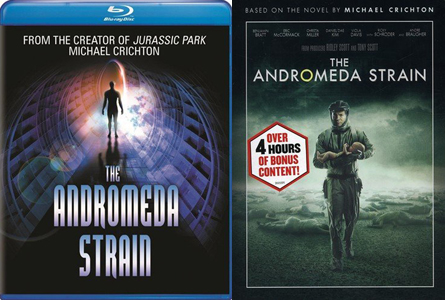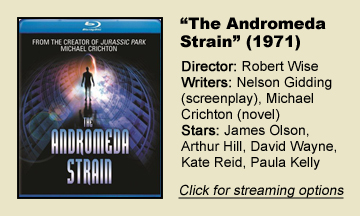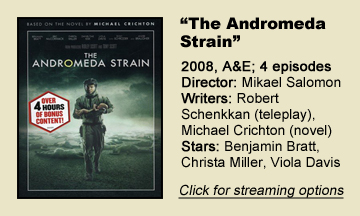I think of the 21st century – starting with 2001’s “Harry Potter and the Sorcerer’s Stone” – as the era of faithful book-to-film adaptations. But they were done before that: A case in point is “The Andromeda Strain” (1971), which might’ve inspired later screenplay writers to not adapt books faithfully.
“The Andromeda Strain” (1971)
Except for some superficial things, and at least one improvement (more personality for the four scientists), Nelson Gidding adapts Michael Crichton’s 1969 novel page-for-page.
The result is a prime example of how film and books are experienced differently. A taut, propulsive thriller on the page becomes a slow, boring slog on screen; it’s 2 hours and 11 minutes long when it should’ve been 1:45. I suspect it was boring for many 1971 viewers, too, although some might’ve been enthralled by the technical achievements. Along those lines, I appreciate “Andromeda” for its historical value.
Wise innovation
Director Robert Wise gives us an early example of multiple images in a frame. When the two scientists investigate the town of Piedmont (changed from Arizona to New Mexico for no apparent reason), one side of the screen shows them peering into homes and the other side shows a snapshot of the corpse therein.
It’s not the best way to build suspense, but maybe it was different enough to be compelling 50 years ago.
As with the only slow part of Crichton’s book, a lot of time is spent showing the quartet moving through the sterilization locks of the five-level Wildfire bunker. This and other specifics of scientific research – and the newfangled notion of computers assisting the process – are fascinating enough to Gidding and Wise (and perhaps some viewers) that they are worth lingering upon.
Dystopian noir
More broadly, “The Andromeda Strain” slots into the categories of dystopian SF and conspiracy noir – both popular in the ’70s.
Gidding gives us a debate between by-the-book team leader Stone (Arthur Hill) and individualist Dutton (David Wayne) about the irresponsibility of the U.S. government in bringing a germ from the upper atmosphere back to Earth, perhaps part of biological-warfare research.
Leavitt (Kate Reid) even throws in a sarcastic “Another giant leap for mankind!” (The film, unlike the book, came out after the first moon landing.)
Throw in the bunker-obscuring desert cornfields, and I’d be stunned if “The X-Files” didn’t draw from “The Andromeda Strain.” Indeed, the two projects both aim to draw suspense from scientists/investigators gleaning little bits of information here and there, and from threats that are tucked away in medical facilities.
Technology trumps thrills
As a techno-thriller, Wise’s film is heavy on the technology, light on the thrills. The tension picks up for the grand finale of Hall (James Olson) climbing the shaft to get to a substation, mainly because self-destruct countdowns are inherently suspenseful. But I can also easily see the “Mystery Science Theater 3000” gang making fun of the sequence.
The acting isn’t bad – the four actors infuse personality into placeholder characters – and the art design, while almost as show-offy as “2001: A Space Odyssey,” is good for its era; this is what a 1971 government science bunker would look like. And it’s the first Crichton adaptation, so – inasmuch as I’m doing this Michael Crichton Monday series – I stayed locked in for the sake of soaking up history.

But judged as an entertainment experience, “The Andromeda Strain” is so slow-paced that the opposite of the rule of thumb applies: For the fast-paced, easily accessible version, skip the movie and read the novel.
Movie: 2.5 stars
“The Andromeda Strain” (2008 miniseries)
“The Andromeda Strain” is a classic example of an old film that’s worthy of a remake: It has name recognition but could use some modernization. Interestingly, the miniseries version of “The Andromeda Strain” (2008) – which came out six months before Crichton’s death – is not a tight thriller but rather an expanded version. The four-episode A&E miniseries runs a total of 3 hours.
A slicker version
Nonetheless, these 3 hours seem to go by faster than the 2:11 of the original film. It’s a superficially slicker, more vibrant, more robust telling of the same story.
Director Mikael Salomon’s miniseries visually looks like any Aughts sci-fi effort, with a diverse and personality-laden team of five scientists (Benjamin Bratt, Christa Miller, Daniel Dae Kim, Viola Davis, Ricky Schroder) theorizing while standing around computer graphics.
Writer Robert Schenkkan uses Crichton’s story framework (but Piedmont is now in Utah), but in the second half he adds enough new elements that “Andromeda” expands beyond a rote exercise in modernization.
New elements
We get a space wormhole, a virus found at the ocean bottom that can fight the titular strain, and super-fast mutation via animals.
Providing tension outside the bunker is TV reporter Jack Nash (Eric McCormack) trying to get the word out about the bioweapon-program-gone-awry while the military (led by Andre Braugher, who refreshingly plays a thoughtful military leader) chases him.
There are also bonds and conflicts between various scientists and family troubles back home, none of which necessarily make the story better.
Probably not on purpose, Schenkkan exposes the silliness of some of the 1970s tech. In the original film, the scientists work on their two survivor patients from a body glove that’s attached to the wall.
In this version, they use simple containment suits. I didn’t think of it while watching the original, but now I see that an airlock and a suit makes more sense than the body glove.
More engrossing
I’m in the odd position where Schenkkan’s new elements made me more engrossed in the story (I had read the book and watched the movie right before this) but in the end I have to admit they don’t make the story better.
They streamline it and push the genre slightly from hard to soft SF, something more akin to “The X-Files” (especially when you throw in government agents murdering people who know too much).
The miniseries softens the Crichtonian notion that random luck plays a big part in disasters. Here, the scientists warn against dropping a tactical nuke because they don’t yet know enough about Andromeda.
In Crichton’s novel, the scientists luck out: Their recommendation to drop the bomb is rejected for political reasons, and later they learn that fire would’ve spread the strain. (Which does happen in the miniseries – an example of it moving into softer SF territory as the team’s challenges move beyond the scope of what’s likely.)
The “Andromeda Strain” update is not a masterpiece, but it’s definitely less boring than the 1971 film (which admittedly is more groundbreaking and more original in style). For anyone who is not a film-history nerd, I’d recommend this version. But again, it can’t compete with Crichton’s novel in science or thrills.
Miniseries: 3.5 stars



